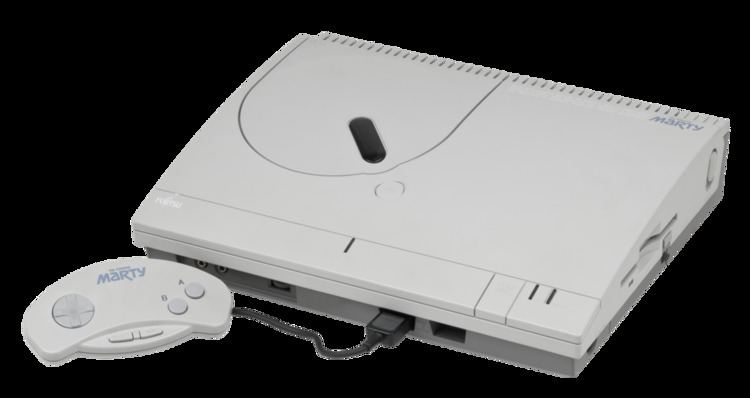Discontinued JP: 1995 (1995) | Release date JP: February 20, 1993 | |
 | ||
Generation Fifth generation (32-bit/64-bit era) Units sold 45,000 (as of December 31, 1993) | ||
The FM Towns Marty (エフエムタウンズマーティー, Efu Emu Taunzu Mātī) is a fifth-generation home video game console released in 1993 by Fujitsu, exclusively for the Japanese market. It was the first 32-bit home video game system, and came complete with a built in CD-ROM drive and disk drive. It was based on the earlier FM Towns computer system Fujitsu had released in 1989. The Marty was backward-compatible with older FM Towns games.
In 1994 a new version of the console called the FM Towns Marty 2 (エフエムタウンズマーティー2, Efu Emu Taunzu Mātī Tsū) was released. It featured a darker gray shell and a new lower price (66,000 yen or 670 USD) but was otherwise identical to the first Marty. It is widely believed that the FM Towns Marty 2 would feature similar improvements to the FM Towns 2, which had a swifter CPU than the first, but this is not the case. It has also been speculated that the Marty 2 featured a 486 CPU, however this was also discovered to be false.
There is also the FM Towns Car Marty (エフエムタウンズカーマーティー, Efu Emu Taunzu Kā Mātī) for installation in automobiles. It included a built in navigation system with audio and video guidance, and could also be detached from the car and played at home. It came in two versions, the MVP-1 (released in April 1994) and MVP-10 (released in November 1994). The only difference between the MVP-1 and MVP-10 is the drive mechanisms. There has been speculation that the MVP-10 was introduced since the MVP-1 broke easily. An optional IC Card for the FM Towns Car Marty allowed it to use VICS, and was subsequently sold with a video monitor.
Reception
Despite having excellent hardware from a gaming perspective, both the FM Towns and the FM Towns Marty were very poor sellers in Japan. They were expensive and the custom hardware meant expandability wasn't as easy as with DOS/V (IBM PC Clones with Japanese DOS or Microsoft Windows) systems. NEC's PC98 series computers were also dominant in Japan when the FM Towns Marty was released, making it difficult to break out before the DOS/V invasion took control of the market. This was despite such revolutionary features as bootable CD-ROMs and a color GUI OS on the FM Towns PC, something that predated Microsoft's Windows 95b bootable CD by seven years. Software today is rare and expensive due to the low production runs. Despite backwards compatibility with most older FM Towns PC games, compatibility issues plagued the Marty as newer titles were released with the FM Towns in mind, further limiting its potential as a true "console version" of the Fujitsu FM Towns PC. The Marty did have its own library of "Marty" specific games, but they were not enough to strengthen its niche position between video game console systems and personal computers.
When Fujitsu lowered the price and released the Marty 2 sales started to increase, but the corporate attitude was that it was a lost cause, and so the system was dropped. This led to the creation of the Japanese "Marty's Law" (マーティーの法則, Mātī no Hōsoku): if you don't keep offering something to sell, you can't increase sales.
